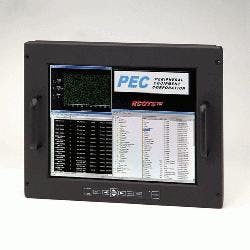By John McHale
WESTLAKE VILLAGE, Calif. — Engineers at Peripheral Equipment Corp. (PEC) in Westlake Village, Calif., are being forced to switch glass suppliers and reduce the sizes of their liquid crystal displays because their existing design is not rugged enough for harsh military environments.
PEC`s predicament may turn out to be a hard lesson — and an example to other military subsystem integrators — of how risky it can be to use components in applications for which the original equipment manufacturers never intended them.
PEC officials claim the 20.1-inch liquid crystal display (LCD) glass they buy from NEC in Japan weakens at -40 degrees Celsius, so they have found a new supplier and are pushing a new 18-inch monitor for extreme harsh environments.
Until last year, PEC leaders had intended their Model 5600 rugged flat-panel LCD monitor for harsh environments with temperatures dipping to -40 C. The problem, however, is that NEC officials recommended against using their 20.1-inch LCD glass for life-critical military applications.
PEC officials learned of the vulnerability of NEC glass to extreme cold at a trade show last year when they exhibited their Model 5600 rugged flat panel LCD. There, an engineer from another company warned PEC`s vice president of sales and marketing, Dale Cooke, to double check the display`s specifications
Specifically, the engineer visiting the PEC booth warned of operating the NEC glass -40 C temperatures, Cooke says. The engineer said his company operated the display under these conditions and the device failed, Cooke says.
Cooke went back to his engineers and found that in the course of development they had tested the display at -40 C for four hours without incident, Cooke says. On Cooke`s advice, PEC engineers re-tested the Model 5600 for 72 hours at -40 C. That is where the troubles began.
They found the liquid crystal in the glass froze and parts of the glass turned black, says Walt Caldwell, product line manager at PEC. Once frozen, the individual pixels lost their alignment, and once it is lost "you don`t get it back," he explains.
The same problems can also happen at -30 C, only it will take longer to occur, Caldwell says.
Cooke admits that NEC specifications for the 20.1-inch glass make clear that the LCD is not to be used in aerospace, submarine, military, and medical applications that may put human life at risk.
This is a big product liability for companies who continue to market a 20.1-inch display to severe cold environments, Cooke warns. Currently NEC makes the only 20.1-inch glass on the market. Other companies are designing a 20.1-inch device, but NEC is the only one with product available, Cooke claims.
PEC officials have since switched to a new glass maker for their Model 5400 18.1-inch LCD monitor, which they are targeting at severe environments. Cooke declined to name PEC`s new glass supplier.
However, he claims that the new device can withstand non-operational temperatures as cold as -40 C for 90 hours. The new glass also has a quicker response time than the NEC glass resulting in clearer images, Cooke claims.
The Model 5400 rugged color monitor is a high-resolution flat panel true color TFT LCD color monitor with automatic sync detection, a 120-degree viewing angle, a front EMI shield with heater, and front panel OSD controls.
PEC`s monitor has a proprietary heating mechanism and was designed to be a direct drop-in replacement for the PEC Model 5600 and other similar rugged cathode ray tube and flat panel color monitors.
The model 5400 is for airborne, shipboard, and ground applications, Cooke says. The majority of interest is currently among airborne applications, he adds.
For more information on the Model 5400 or Peripheral Equipment Corp., contact Dale Cooke by phone at 818-707-2890, by fax at 818-707-2895, by mail at Peripheral Equipment Corp., 31238 Via Colinas, Suite C, Westlake Village, Calif. 91362-3900, by email at [email protected], or on the World Wide Web at http://www. rcots.com.
The 18.1-inch Model 5400 rugged color monitor from Peripheral Equipment Corp. uses a new glass maker and is getting a lot of interest among airborne applications.




